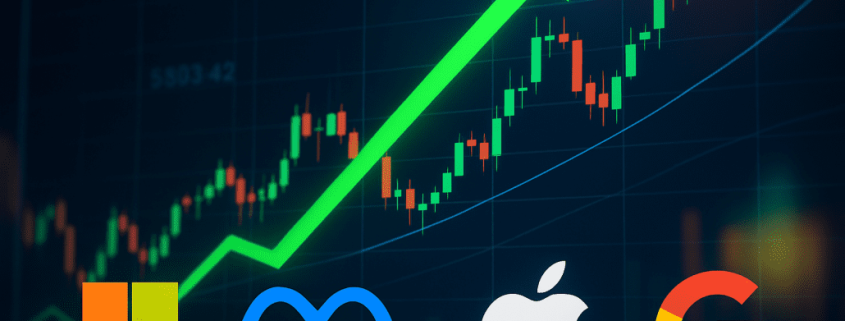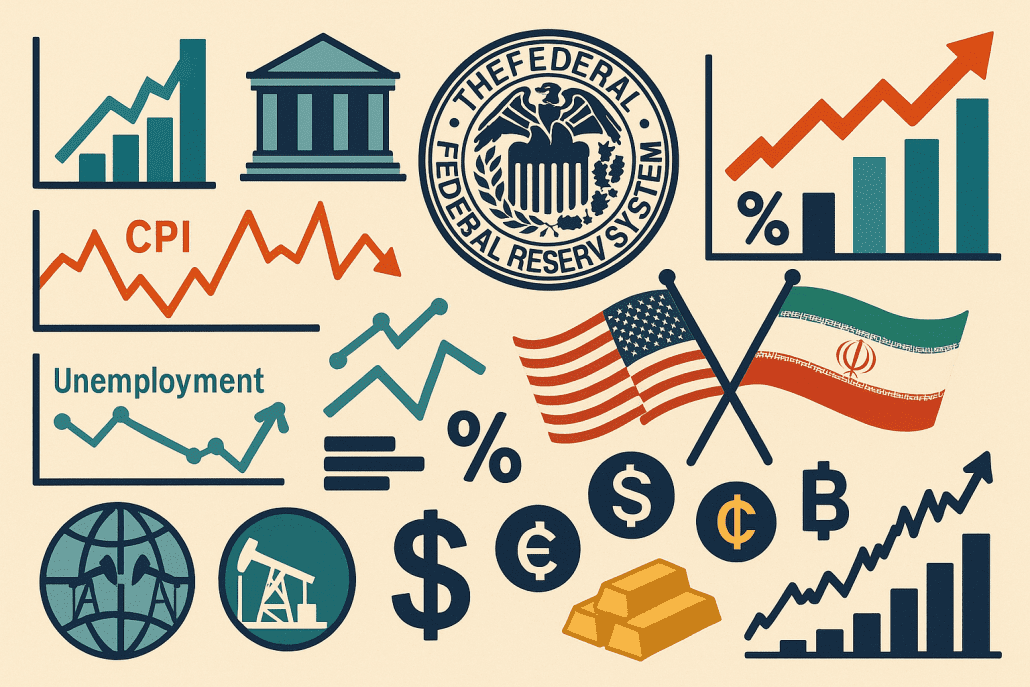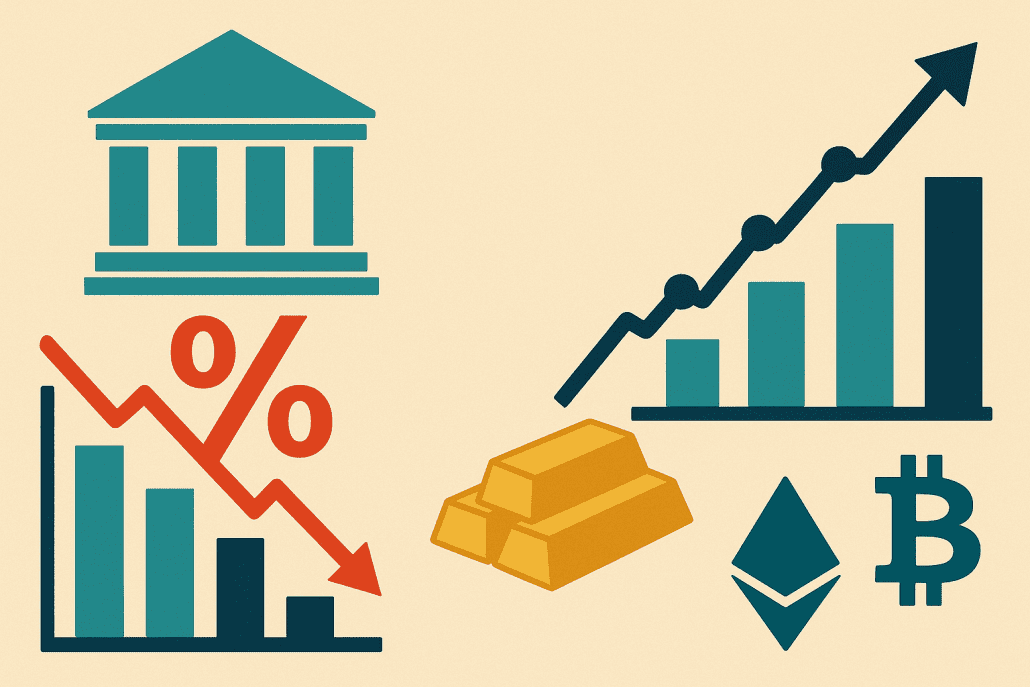Monthly Market Wrap (July 2025)
Join our Telegram channel for more market analysis & trading tips: t.me/synapsetrading
Table of Contents
Global Stock Market Trends
July 2025 was broadly positive for equity markets. In the US, the S&P 500 and Nasdaq Composite notched their third consecutive month of gains, hitting multiple record highs during the month. The S&P 500 rose about 2.2% in July, while the tech-heavy Nasdaq jumped 3.7%, buoyed by strong corporate earnings and investor optimism. The Dow Jones Industrial Average lagged with a roughly flat month (0.1%), but even the Dow extended its winning streak to three months.
Major European and Asian stock indices also climbed amid the global rally, though to a lesser extent. Europe’s STOXX 600 and other regional indexes posted modest gains, supported by improving economic sentiment and easing policy uncertainty. Notably, mega-cap technology stocks, the “Magnificent Seven,” powered much of the US market’s strength, with a key tech index hitting all-time highs. This came as Microsoft briefly topped a $4 trillion market valuation and Meta surged to record share prices on stellar earnings. Overall, global equities proved resilient in July, advancing despite ongoing trade war tensions and other risks.
Macroeconomic & Central Bank Developments
Economic data in July painted a picture of solid growth with nascent signs of cooling. In the US, second-quarter GDP grew at an annualized 3% pace, stronger than expected and indicating continued economic expansion. The labor market remained robust but showed some slowing: June payrolls (reported in early July) rose by 147,000, the weakest gain since last fall, and the unemployment rate hovered just above 4%. Inflation data was mixed – consumer price inflation ticked up in June, influenced in part by new import tariffs driving up costs. Nonetheless, core price trends remained moderate, and consumer sentiment reached a five-month high on the back of the stock rally.
Central banks took a cautious pause in July. The US Federal Reserve left its benchmark interest rate unchanged in the 4.25% to 4.50% range, despite open pressure from President Trump for rate cuts. Two Fed governors dissented in favor of cutting rates, but Chair Jerome Powell emphasized that the Fed’s priority is taming inflation, which remains “somewhat elevated,” and that it needs more data on the impact of trade policies before easing. Powell’s hawkish tone dampened market hopes of any quick rate cuts, leading investors to drastically scale back expectations of a September policy easing.
Across the Atlantic, the European Central Bank (ECB) also held its key rate steady at 2.00%, pausing after a year of monetary easing. With eurozone inflation back at the 2% target and growth holding up, ECB policymakers opted to wait and assess incoming data, especially given uncertainty around Europe’s trade relations with the US. The ECB noted that domestic price pressures have eased and signaled a meeting-by-meeting approach as it monitors if US tariff conflicts will undercut European growth. Meanwhile, China’s economy grew about 5.2% year-on-year in Q2, roughly on target, but faces headwinds.
Chinese data showed persistent weakness in the property sector and cautious consumer spending, partly due to the overhang of US tariffs. Beijing’s leadership refrained from major new stimulus in July, opting for targeted support measures as long as growth stays near 5%. Notably, a temporary US–China trade truce (and firms rushing shipments before tariff deadlines) helped China avoid a sharper slowdown so far. Overall, global monetary policy was characterized by patience and vigilance, as central bankers balanced cooling inflation and growth against the uncertain impact of trade conflicts.
Trade War and Political Developments
Trade policy and geopolitics were major market factors in July. The US–China trade war entered a new phase as President Donald Trump threatened broad tariff hikes on countries lacking trade agreements with the US by summer’s end. Early in the month, the White House announced steep new duties (some exceeding 30% to 50%) on imports from dozens of nations including allies like Canada, Brazil, India, Switzerland, Thailand, and Taiwan to take effect if deals weren’t reached by an August deadline. These moves aimed to “reorder the global economy” and represented the highest US tariff rates since the 1930s, sending global markets tumbling at times as investors feared escalating protectionism.
However, intensive negotiations through July yielded some relief. The White House struck trade agreements in principle with many partners (and granted certain reprieves, such as a 90-day extension for Mexico) to avoid the harshest tariffs. For example, diplomats indicated the US and EU were moving toward a deal that might impose a simplified 15% tariff regime on European goods, an outcome worse for Europe than status quo, but better than earlier feared blanket hikes. These eleventh-hour deals and exemptions eased tariff anxieties in the latter part of the month, helping equity markets rebound from an April–May selloff that had been sparked by initial tariff announcements. By month-end, uncertainty remained (with a final tariff deadline looming on August 1), but the general tone shifted to cautious optimism that many trade partners would avert the most punitive duties.
On the domestic US front, political developments also impacted specific sectors. The Trump administration took aim at high drug prices, with the President sending letters to CEOs of 17 major pharmaceutical companies urging immediate price cuts. This unexpected intervention drove pharma stocks lower; the NYSE Pharma Index slumped nearly 3% in one day, its worst drop since May. Separately, President Trump continued his public pressure on the Fed via social media and speeches, demanding deep interest rate cuts to stimulate growth, an unprecedented campaign that raised concerns about Fed independence. Two Fed officials appointed by Trump even dissented at the July meeting in favor of cuts, highlighting this tension.
Abroad, geopolitical flashpoints simmered but did not severely jolt markets in July. The conflict between Israel and Iran (including unrest in the Persian Gulf) drove oil prices higher early in the month, but fears of a broader Middle East escalation faded as the situation stabilized. The ongoing war in Ukraine and other global risks continued in the background, but investors appeared more focused on trade and economic news. Overall, political news in July had a palpable market impact, with active US trade and industrial policies creating pockets of volatility even as broad investor sentiment improved once worst-case outcomes were averted.
Corporate Earnings and Stock Market Movers
July also kicked off the Q2 corporate earnings season, which delivered generally better-than-expected results, especially from US technology giants. Roughly 80% of S&P 500 companies beat earnings forecasts by the end of the month, a higher “beat rate” than recent averages, boosting confidence that corporate America remains resilient. Big Tech in particular posted standout numbers that drove major stock moves:
-
Microsoft (MSFT) reported strong quarterly earnings, fueled by growth in cloud and AI services. Its stock jumped about 3% to 4% on the results, briefly pushing Microsoft’s market capitalization above the historic $4 trillion threshold during trading. Microsoft became only the second company ever to reach that valuation (after earlier moves by Nvidia).
-
Meta Platforms (META) blew past expectations with surging advertising revenues and an upbeat forecast, crediting AI-driven improvements in ad targeting. Meta’s stock soared 11% in one day, hitting an all-time high above $770 per share. This double-digit gain in a mega-cap name was the standout move of the month, cementing Meta’s year-to-date leadership.
-
Alphabet/Google (GOOGL) also delivered solid results (boosted by cloud and search advertising), though its stock reaction was more muted. After a strong run-up prior to earnings, Alphabet shares seesawed and ended July roughly flat to slightly up, as investors rotated into other tech names.
-
Amazon (AMZN) posted a 13% jump in revenue (to $167.7 billion) and better-than-expected profits, with Amazon Web Services (AWS) growth of 18% beating forecasts. However, investors were underwhelmed by Amazon’s outlook and possibly expected even more in cloud business after Microsoft’s blowout. As a result, Amazon’s stock initially climbed in anticipation but then fell about 2% to 3% after earnings, trimming its gains. Essentially, Amazon’s strong quarter was viewed as “good, not great” relative to sky-high hopes.
-
Apple (AAPL), reporting at month-end, topped analyst estimates with a 10% rise in revenue (to $94 billion) and improved profits. iPhone sales jumped 13% and Services revenue hit a record, offsetting dips in iPad sales. Apple’s stock, which had been down approximately 17% for the year, popped about 3% in after-hours trading on the earnings beat. Investors were relieved by Apple’s return to growth and signs of strength in its ecosystem.
-
Among other notable tech names, Tesla (TSLA) had a more mixed showing. Tesla’s earnings indicated a squeeze on profit margins, revenue actually fell slightly amid aggressive EV price cuts, and Elon Musk warned of “rough quarters ahead” as the company transitions technologies. Tesla’s stock seesawed in July, rallying early in the month but slipping about 3% after the Q2 report and guidance to finish roughly flat. Similarly, Nvidia (NVDA), the year’s star performer on AI chip demand, took a breather; its shares edged down about 1% on the last day of July, as investors locked in some profits despite no new earnings from Nvidia during the month.
Outside of big tech, semiconductor stocks and other AI beneficiaries had a volatile month. While the AI boom remained a major theme, there was a bit of a rotation in late July: chipmakers like Broadcom (AVGO) and Qualcomm (QCOM) saw their stocks drop sharply. Broadcom slid approximately 3% on concerns of peaking chip demand, and Qualcomm plunged 8% in one day amid a soft outlook and news that Apple will soon use its own iPhone modems (threatening Qualcomm’s future revenue). Those declines dragged the Philadelphia Semiconductor Index down over 3% on July 31, its worst day since April. Meanwhile, enterprise tech and communications firms had some winners: for instance, Comcast (CMCSA) climbed on solid results, and IBM and AT&T posted steady performances that reassured investors in the beaten-down telecom sector.
Crucially, the earnings season also produced major moves in individual stocks beyond tech. Some companies delivered exceptionally strong results and outlooks, igniting huge rallies:
-
eBay (EBAY) surged 18% in a single day, leading the S&P 500, after the online marketplace beat sales and profit estimates and issued upbeat guidance for next quarter. EBay’s gross merchandise volumes rebounded more than expected, signaling a turnaround in e-commerce activity.
-
C.H. Robinson Worldwide (CHRW), a freight logistics company, similarly jumped 18% post-earnings. It reported better-than-expected revenue and profits thanks to aggressive cost-cutting (including layoffs) that expanded its margins. This was a dramatic rebound for a transportation stock that had struggled with freight downturns.
-
Carvana (CVNA), the online used-car seller and one-time meme stock, saw its shares soar 17% after it surprised Wall Street with improving finances and possibly some restructuring progress. Heavy short interest likely fueled this sharp rally as traders rushed to cover positions.
On the flip side, there were some big disappointments and collapses:
-
Align Technology (ALGN), maker of Invisalign dental aligners, suffered a disastrous report. Its earnings missed expectations and it announced layoffs and a restructuring. Align’s stock plunged a stunning 37% in one day, marking the worst S&P 500 performance of the month. The company’s outlook was hurt by slowing orthodontic demand and one-time charges for the restructuring.
-
Baxter International (BAX), a medical products firm, cut its 2025 forecast after a weak quarter (still reeling from supply disruptions and soft hospital demand). Baxter’s stock tumbled 22% to a 19-year low on the news, as investors were shocked by the magnitude of the miss and the reduced guidance.
-
Anheuser-Busch InBev (BUD), the global beer giant, saw shares drop about 13% after reporting declining North American sales. Lingering consumer boycotts in the US (related to earlier controversies) and overall volume declines hit its earnings. The steep fall erased much of BUD’s year-to-date gains and highlighted ongoing brand challenges.
-
International Paper (IP) fell nearly 13% as well, after the packaging manufacturer missed profit estimates due to weak European demand and maintenance outages. This underscored how industrial and materials companies exposed to Europe are feeling the pinch of a slowing global manufacturing cycle.
Overall, the earnings season narrative was positive, with strong aggregate growth, especially in tech. The S&P 500’s earnings beats, combined with easing macro fears, helped lift the index to new highs. Yet stock reactions were highly differentiated: investors rewarded clear winners with outsized one-day gains of 10% to 20% in some cases and punished any significant misses with 20% to 35% implosions. This environment created rich trading opportunities and underscored the importance of guidance and forward-looking commentary.
Commodities, Bonds, and Other Assets
July saw notable moves across other asset classes as well. In the oil market, prices swung on geopolitical and OPEC-related news. Early in the month, crude oil jumped (Brent and WTI climbed roughly 8% to 10%) amid Middle East tensions, after conflict flared between Israel and Iran and raised fears of supply disruptions. US WTI crude hit a five-week high around $70 per barrel. However, later in July, oil eased off highs as supply fears abated and rumors emerged that OPEC might boost production to stabilize prices. By month-end, WTI crude settled near $69 per barrel, up slightly on the month.
In contrast, gold prices spiked to all-time highs during July amid the backdrop of trade uncertainty and inflation hedging. Gold futures briefly traded above $3,300 an ounce, a record level, as investors sought safety. Late in the month, gold saw a sharp pullback (down about 0.3% on July 31) as real interest rates inched up, but it remained dramatically higher year-to-date, reflecting strong safe-haven demand.
In currency and bond markets, the US Dollar Index (DXY) strengthened significantly. The dollar had its best month of 2025, climbing to about 100.0 on the index (the highest since mid-May) bolstered by higher US yields and safe-haven flows on tariff worries. Notably, the Japanese yen weakened to multi-month lows (amid speculation of continued easy policy by the Bank of Japan), and the euro also softened slightly given Europe’s growth jitters.
US Treasury yields were relatively stable but finished at elevated levels. The 10-year Treasury yield hovered around 4.3% to 4.4% at the end of July, roughly unchanged from a month prior, as strong economic data offset hopes of any Fed rate cuts. Shorter-term yields stayed near the Fed’s policy rate, resulting in a continued inverted yield curve (a sign of future growth concerns). Credit markets were calm; US investment-grade and high-yield corporate bonds earned modest positive returns as investors chased yield with recession fears receding.
Cryptocurrency Highlights
The cryptocurrency market saw a major resurgence in July, led by the two largest digital assets. Bitcoin (BTC) extended its remarkable 2025 rally, trading above $115,000 by late July. In fact, Bitcoin briefly hit an intraday high near $119,000, a level unimaginable just a couple of years ago, before a bout of profit-taking pulled it back slightly. Even with some end-of-month volatility, Bitcoin’s price was up substantially over the month, reflecting both a broad crypto bull trend and its appeal as a hedge in an environment of persistent inflation and currency uncertainties.
Market analysts noted that over $600 million in bullish BTC bets were liquidated during a quick mid-week drop (when BTC fell from around $119K to $115K), but the coin swiftly recouped those losses, showcasing resilient demand. Interest in Bitcoin was fueled by factors like institutional adoption (such as renewed hopes for a Bitcoin ETF approval in the US), inflation hedge narratives, and even concerns about the Fed’s independence – some crypto investors speculated that political pressure on central banks could enhance Bitcoin’s long-term appeal as an alternative asset.
The standout crypto story, however, was Ethereum (ETH). Ethereum’s price skyrocketed over 50% in July, massively outperforming Bitcoin and most other assets. By late July, Ether crossed $3,800 (its highest in seven months) after starting the month around the mid-$2,000s. In percentage terms, Ethereum gained approximately 54.8% in one month, its best monthly performance in three years, as it led the crypto market.
Several factors drove this surge: Ethereum saw large capital inflows (around $2.8 billion net in July) amid renewed investor confidence. On-chain activity on Ethereum also hit record levels, with daily gas usage (a proxy for transaction and smart contract demand) reaching all-time highs. This suggests booming usage of Ethereum-based decentralized applications and possibly the impact of new Layer-2 scaling solutions attracting users. Moreover, July’s risk-on environment and some speculation around potential Ethereum ETF filings or upcoming network upgrades might have boosted sentiment. By month-end, ETH was trading near $3,800 to $3,900, firmly establishing itself as one of the top-performing major assets of 2025 so far. Traders noted that Ether’s rally was so rapid that it closed July at multi-month highs and logged its strongest July on record, prompting discussion of whether it might be overextended or entering a new adoption-driven phase.
The broader crypto ecosystem followed Bitcoin and Ether higher: total crypto market capitalization grew, and altcoins rallied (though with high volatility). Importantly, crypto markets showed resilience even when equities wobbled late in the month. When stocks pulled back on Fed concerns and tariff headlines, Bitcoin initially dipped (falling below $115K momentarily) but then stabilized and rebounded within 24 hours. Some analysts interpreted this as crypto decoupling slightly from traditional risk assets, possibly trading on its own fundamentals of network demand and as digital gold.
However, others cautioned that if tariffs drive inflation up in coming months, it could be a two-edged sword: initially hurting crypto as risk sentiment declines, but potentially helping Bitcoin later as inflation-hedge and hard-asset narratives strengthen. For now, July ended with crypto market optimism at a high, Bitcoin firmly above six figures and Ethereum’s momentum attracting both retail and institutional interest.
Concluding Thoughts
July 2025 saw a powerful rally in US equities, with the S&P 500 and Nasdaq reaching new all-time highs. The gains were driven primarily by strong earnings from Big Tech, as Microsoft, Meta, Apple, and Google all exceeded expectations, reinforcing confidence in the AI and cloud growth narrative. At the same time, the market showed little forgiveness for underperformance, as seen in the steep declines of companies like Align Technology and Baxter following disappointing results. This selective reaction suggests a high-stakes earnings environment where investors are quick to reward clear winners and equally quick to exit laggards. As such, the most effective strategy now is to ride strength in quality leaders while being disciplined with risk, especially around earnings. Tech and AI names with consistent growth remain strong candidates, but speculative positions without conviction should be avoided heading into earnings reports.
Macroeconomic data painted a picture of steady but slightly cooling growth. US GDP expanded at a solid 3% annualized pace, while unemployment remained low. Inflation ticked up modestly, partly due to new tariffs, but core trends stayed manageable. The Fed and ECB both paused on rate changes, opting for a wait-and-see approach. Fed Chair Powell emphasized caution and data dependence, pushing back against political pressure for immediate cuts. With monetary policy still on hold and inflation not yet low enough to prompt easing, markets are especially sensitive to economic data releases. In this environment, sectors that benefit from a soft landing such as technology and consumer discretionary are likely to outperform, while rate-sensitive sectors like REITs and utilities may struggle unless clearer dovish signals emerge.
Geopolitically, trade tensions re-emerged as a major market theme. The White House announced steep tariff threats on a broad range of US trading partners, initially triggering market anxiety. However, investor sentiment recovered later in the month as many nations reached temporary deals or received exemptions, easing fears of an immediate global trade war. Still, with key deadlines approaching in August, uncertainty lingers. Investors would be wise to stay agile. If trade tensions escalate again, defensive positioning in healthcare, consumer staples, or safe-haven assets like gold and the dollar may prove prudent. Conversely, if trade risks fade, there may be opportunities in oversold global cyclicals or exporters, particularly in Europe and Asia.
Commodities reflected the broader risk-on mood. Oil prices jumped early in the month due to Middle East tensions but stabilized as supply fears eased. Gold surged to a record high above $3,300 amid safe-haven demand and inflation concerns before pulling back slightly. Meanwhile, the US dollar had its best month of the year, and bond yields remained elevated around 4.3%, reflecting strong growth and reduced expectations for rate cuts. Investors holding gold should consider tightening stops or taking partial profits, as the rally could face resistance if real yields continue rising. In the bond market, duration risk remains high. Positioning in shorter-term or floating-rate bonds offers a safer approach until rate direction becomes clearer.
Crypto markets delivered the most explosive gains. Bitcoin continued its 2025 bull run, trading between $115K and $120K, while Ethereum posted a staggering 50% monthly gain, fueled by surging network usage and strong capital inflows. Ethereum’s outperformance makes it a standout trend candidate, though traders should wait for consolidation or pullbacks before adding exposure. Bitcoin, showing signs of steady institutional accumulation, may offer compelling reentry opportunities on dips toward the $100K to $105K range.
Overall, July ended on a note of cautious optimism. Strong earnings, stable central bank policy, and temporary relief on trade helped lift risk assets across the board. But with key macro data and tariff decisions looming in August, investors should stay focused on high-quality growth opportunities while managing risk with discipline. The tone remains constructive, but agility will be key in navigating the next leg of the market cycle.
 Our flagship mentoring program is suitable for both beginners and advanced traders, covering the 4 strategies which I used over the past 15 years to build up my 7-figure personal trading portfolio.
Our flagship mentoring program is suitable for both beginners and advanced traders, covering the 4 strategies which I used over the past 15 years to build up my 7-figure personal trading portfolio.
 If you're looking for a reputable brokerage that covers all products (SG stocks, US stocks, global stocks, bonds, ETFs, REITs, forex, futures, crypto) and has one of the lowest commissions, this is what I currently use.
If you're looking for a reputable brokerage that covers all products (SG stocks, US stocks, global stocks, bonds, ETFs, REITs, forex, futures, crypto) and has one of the lowest commissions, this is what I currently use.
After trading for 18 years, reading 1500+ books, and mentoring 1000+ traders, I specialise in helping people improve their trading results, by using tested trading strategies, and making better decisions via decision science.






Leave a Reply
Want to join the discussion?Feel free to contribute!